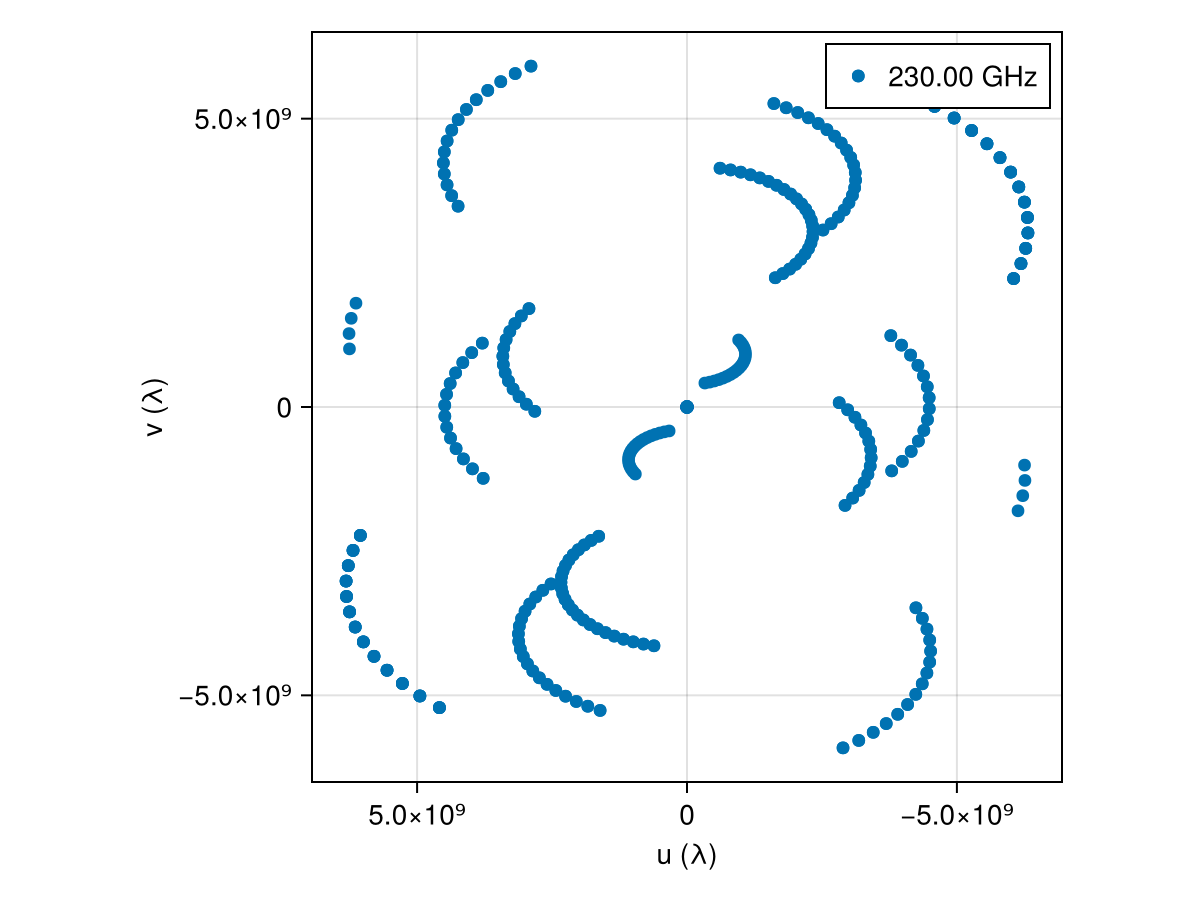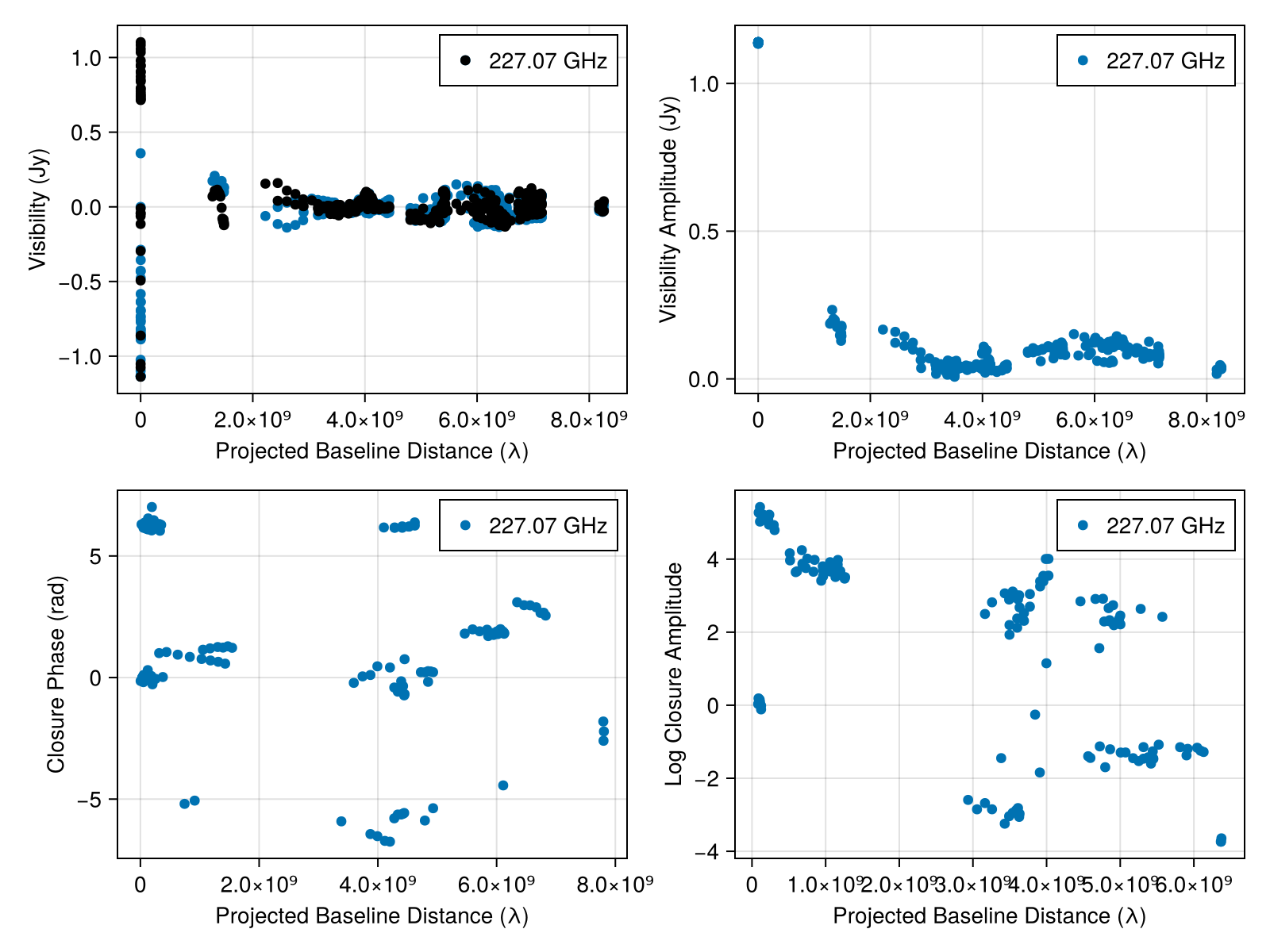Loading Data into Comrade
The VLBI field does not have a standardized data format, and the EHT uses a particular uvfits format similar to the optical interferometry oifits format. As a result, we reuse the excellent eht-imaging package to load data into Comrade.
Once the data is loaded, we then convert the data into the tabular format Comrade expects. Note that this may change to a Julia package as the Julia radio astronomy group grows.
To get started, we will load Comrade and Plots to enable visualizations of the data
using Comrade
using CairoMakieWe also load Pyehtim since it loads eht-imaging into Julia using PythonCall and exports the variable ehtim
using Pyehtim/home/runner/work/Comrade.jl/Comrade.jl/examples/beginner/LoadingData/.CondaPkg/.pixi/envs/default/lib/python3.11/site-packages/ehtim/__init__.py:58: UserWarning: pkg_resources is deprecated as an API. See https://setuptools.pypa.io/en/latest/pkg_resources.html. The pkg_resources package is slated for removal as early as 2025-11-30. Refrain from using this package or pin to Setuptools<81.
import pkg_resourcesTo load the data we will use eht-imaging. We will use the 2017 public M87 data which can be downloaded from cyverse
obseht = ehtim.obsdata.load_uvfits(joinpath(__DIR, "..", "..", "Data", "SR1_M87_2017_096_lo_hops_netcal_StokesI.uvfits"))Python: <ehtim.obsdata.Obsdata object at 0x7f00fd1ef9d0>Now we will average the data over telescope scans. Note that the EHT data has been pre-calibrated so this averaging doesn't induce large coherence losses.
obs = Pyehtim.scan_average(obseht)Python: <ehtim.obsdata.Obsdata object at 0x7f01011cb2d0>Warning
We use a custom scan-averaging function to ensure that the scan-times are homogenized.
We can now extract data products that Comrade can use
vis = extract_table(obs, Visibilities()) ## complex visibilites
amp = extract_table(obs, VisibilityAmplitudes()) ## visibility amplitudes
cphase = extract_table(obs, ClosurePhases(; snrcut = 3.0)) ## extract minimal set of closure phases
lcamp = extract_table(obs, LogClosureAmplitudes(; snrcut = 3.0)) ## extract minimal set of log-closure amplitudesEHTObservationTable{Comrade.EHTLogClosureAmplitudeDatum{:I}}
source: M87
mjd: 57849
bandwidth: 1.856e9
sites: [:AA, :AP, :AZ, :JC, :LM, :PV, :SM]
nsamples: 129For polarization we first load the data in the cirular polarization basis Additionally, we load the array table at the same time to load the telescope mounts.
obseht = Pyehtim.load_uvfits_and_array(
joinpath(__DIR, "..", "..", "Data", "polarized_gaussian_all_corruptions.uvfits"),
joinpath(__DIR, "..", "..", "Data", "array.txt"),
polrep = "circ"
)
obs = Pyehtim.scan_average(obseht)
coh = extract_table(obs, Coherencies())EHTObservationTable{Comrade.EHTCoherencyDatum{Float64}}
source: 17.761122472222223:-28.992189444444445
mjd: 51544
bandwidth: 1.0e9
sites: [:AA, :AP, :AZ, :JC, :LM, :PV, :SM]
nsamples: 315Warning
Always use our extract_cphase and extract_lcamp functions to find the closures eht-imaging will sometimes incorrectly calculate a non-redundant set of closures.
We can also recover the array used in the observation using
using DisplayAs
plotfields(coh, U, V, axis_kwargs = (xreversed = true,)) |> DisplayAs.PNG |> DisplayAs.Text # Plot the baseline coverage
As of Comrade 0.11.7 Makie is the preferred plotting tool. For plotting data there are two classes of functions:
baselineplotwhich gives complete control of plottingplotfields, axisfieldswhich are more automated and limited but will automatically add labels, legends, titles etc.
fig = Figure(; size = (800, 600))
plotfields!(fig[1, 1], vis, uvdist, measurement)
plotfields!(fig[1, 2], amp, uvdist, measurement)
plotfields!(fig[2, 1], cphase, uvdist, measurement)
plotfields!(fig[2, 2], lcamp, uvdist, measurement)
fig |> DisplayAs.PNG |> DisplayAs.Text
And also the coherency matrices. Since the data products are a matrix we need to plot each one separately.
fig = Figure(; size = (800, 600))
plotfields!(fig[1, 1], coh, uvdist, x -> measwnoise(x)[1, 1], axis_kwargs = (ylabel = "RR", xlabel = "uv distance (Gλ)"))
plotfields!(fig[2, 1], coh, uvdist, x -> measwnoise(x)[2, 1], axis_kwargs = (ylabel = "LR", xlabel = "uv distance (Gλ)"))
plotfields!(fig[1, 2], coh, uvdist, x -> measwnoise(x)[1, 2], axis_kwargs = (ylabel = "RL", xlabel = "uv distance (Gλ)"))
plotfields!(fig[2, 2], coh, uvdist, x -> measwnoise(x)[2, 2], axis_kwargs = (ylabel = "LL", xlabel = "uv distance (Gλ)"))
figYou can also plot a single baseline
fig, ax = plotfields(coh, (:AA, :LM), Ti, x -> abs(measwnoise(x)[1, 1]), axis_kwargs = (; ylabel = "|RR|"))
ax2 = plotfields!(fig[1, 2], coh, (:LM, :AZ), Ti, x -> abs(measwnoise(x)[1, 1]), axis_kwargs = (; ylabel = "|RR|"))
figFinally, we provide a more low-level plotting function baselineplot which allows you to plot any field against any other field. This is what plotfields calls under the hood. However, it does not automatically add labels, legends, titles etc, but can add multiple baselines to the same plot.
fig, ax = baselineplot(coh, (:AA, :LM), Ti, x -> abs(measwnoise(x)[1, 1]), label = "AA-LM")
baselineplot!(ax, coh, (:LM, :AZ), Ti, x -> abs(measwnoise(x)[1, 1]), label = "LM-AZ")
ax.ylabel = "|RR|"
ax.xlabel = "Time (UTC)"
axislegend(ax)
figThis page was generated using Literate.jl.